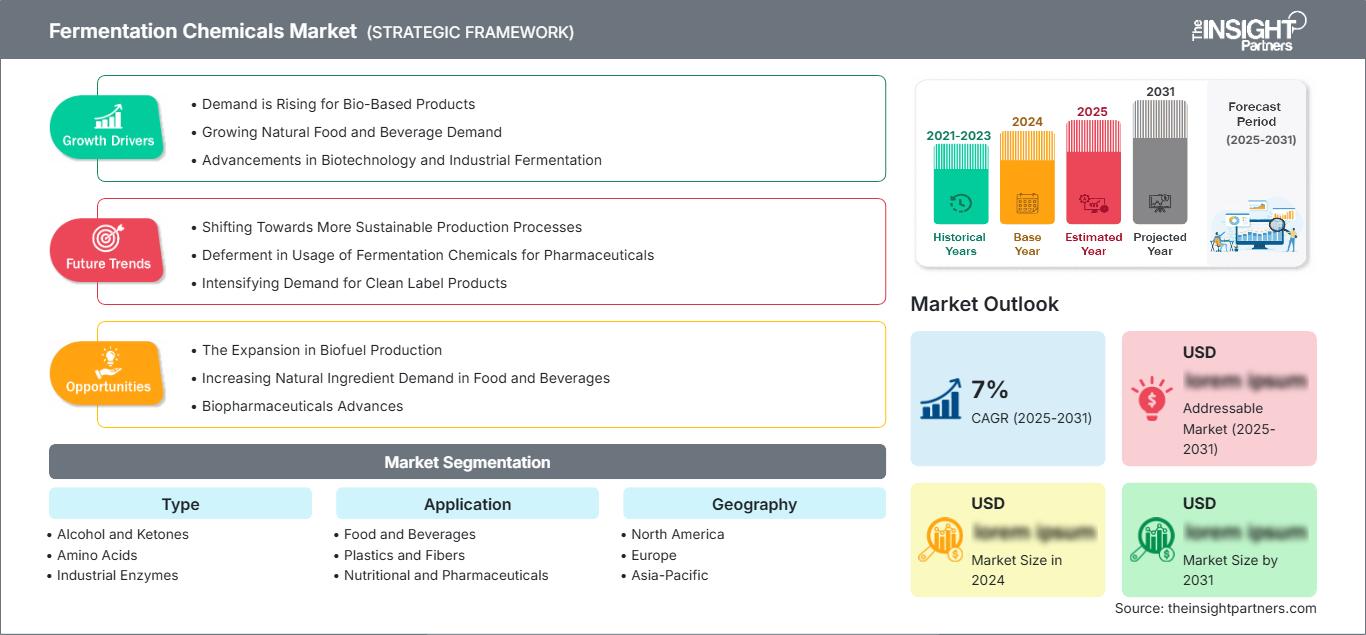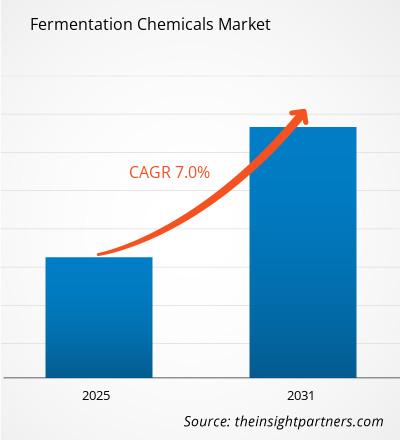预计发酵化学品市场在2025年至2031年间的复合年增长率为7%,市场规模将从2024年的XX百万美元扩大到2031年的XX百万美元。
发酵化学品市场分析涵盖以下几个方面:类型(酒精和酮、氨基酸、工业酶、有机酸等)、应用(食品和饮料、塑料和纤维、营养和药品、工业应用、化妆品和盥洗用品等)和地域(北美、欧洲、亚太地区、中东和非洲、南美和中美)。全球发酵化学品市场预计复合年增长率约为6%。发酵化学品的增长是由对生物基原材料日益增长的需求驱动的,尤其是在工业生物技术领域。
报告目的
Insight Partners 撰写的《发酵化学品市场》报告旨在描述当前的市场格局和未来的增长、主要驱动因素、挑战和机遇。这将为各业务利益相关者提供见解,例如:
- 技术提供商/制造商:了解不断变化的市场动态并掌握潜在的增长机会,使他们能够做出明智的战略决策。
- 投资者:对市场增长率、市场财务预测以及整个价值链中存在的机会进行全面的趋势分析。
- 监管机构:规范市场政策和警察活动,以最大限度地减少滥用,维护投资者的信任和信心,并维护市场的完整性和稳定性。
发酵化学品市场细分类型
- 酒精和酮
- 氨基酸
- 工业酶
- 有机酸
应用
- 食品和饮料
- 塑料和纤维
- 营养和药品
- 工业应用
- 化妆品和盥洗用品
您将免费获得任何报告的定制,包括本报告的部分内容,或国家级分析、Excel 数据包,以及为初创企业和大学提供超值优惠和折扣
发酵化学品市场: 战略洞察

-
获取本报告的主要市场趋势。这个免费样本将包括数据分析,从市场趋势到估计和预测。
发酵化学品市场增长动力
- 生物基产品需求不断增长:发酵化学品的专业市场受到向可持续和绿色产品的转型的推动。它们为石化衍生产品提供了更环保的替代品,以满足消费者对生物基化学品、药品和食品添加剂日益增长的需求——发酵工艺持续推动着该行业的发展。
- 天然食品和饮料需求不断增长:对有机和天然食品及饮料的需求日益增长,推动着发酵化学品市场的增长轨迹。这些化学品有助于保存食物、增强其风味,并在发酵过程中发挥作用,因此,它们构成了满足新时代消费者对更清洁、更健康、不含防腐剂产品需求的关键环节。
- 生物技术和工业发酵的进步:先进的生物技术和发酵工艺方法正在提高发酵化学品的生产效率。基因工程的进步、酶技术和优化的发酵工艺使得高产量和低成本发酵成为可能,也是推动制药和生物燃料等行业市场增长的因素之一。
发酵化学品市场未来趋势
- 向更可持续的生产工艺转变:发酵化学品市场一直在向更环保的制造方法转型。随着对绿色和可再生产品的需求逐渐增加,各行业正通过发酵工艺而非传统化学工艺来驱动,它们将植物糖等可再生原料视为化石燃料的替代品,以减少环境足迹并降低能源消耗。
- 制药行业推迟使用发酵化学品:发酵化学品在制药行业的发展势头迅猛,其在抗生素、酶和其他生物制剂中的应用日益广泛。患者土壤疾病的增加以及个性化医疗对发酵工艺提出了强烈的需求,这些工艺都具有成本效益且可扩展。因此,这将主要影响高品质药物成分的生产。
- 清洁标签产品需求日益增长:消费者对清洁标签和天然产品的需求正在推动食品和饮料行业对发酵化学品的需求。随着社会对不含添加剂和防腐剂的产品的强烈需求,发酵工艺越来越多地被用于生产天然香料、防腐剂、功能性成分以及其他不含合成化学品的成分。
发酵化学品市场机遇
- 生物燃料生产的扩张:全球对可再生能源的大规模传统需求为发酵化学品市场带来了机遇。乙醇和丁醇均由发酵工艺生产。随着各国政府持续倡导清洁能源,将其视为全球最具前景的途径,发酵化学品在生物燃料生产中的应用将取得重大突破。
- 食品和饮料中天然成分需求的不断增长:消费者对清洁标签甚至天然成分开采的新兴观念,为食品和饮料制造中的发酵化学品带来了机遇。发酵化学品可以增强风味、保鲜并生产天然添加剂;因此,它们满足了更健康、可持续来源食品的需求。
- 生物制药的进展:随着生物制剂和个性化药物的兴起,发酵化学品市场在制药领域迎来了巨大的机遇。随着疫苗需求的不断增长以及更具成本效益的药物生产方式的出现,发酵工艺成为生产活性药物成分 (API) 和酶的主要方法。
发酵化学品市场区域洞察
The Insight Partners 的分析师已详尽阐述了预测期内影响发酵化学品市场的区域趋势和因素。本节还讨论了北美、欧洲、亚太地区、中东和非洲以及南美和中美洲的发酵化学品市场细分和地域分布。
发酵化学品市场报告范围
| 报告属性 | 细节 |
|---|---|
| 市场规模 2024 | US$ XX million |
| 市场规模 2031 | US$ XX Million |
| 全球复合年增长率 (2025 - 2031) | 7% |
| 历史数据 | 2021-2023 |
| 预测期 | 2025-2031 |
| 涵盖的领域 |
By 类型
|
| 覆盖地区和国家 |
北美
|
| 市场领导者和主要公司简介 |
|
发酵化学品市场参与者密度:了解其对业务动态的影响
发酵化学品市场正在快速增长,这得益于终端用户需求的不断增长,而这些需求的驱动因素包括消费者偏好的演变、技术进步以及对产品优势的认知度的提升。随着需求的增长,企业正在扩展产品线,不断创新以满足消费者需求,并抓住新兴趋势,从而进一步推动市场增长。

- 获取 发酵化学品市场 主要参与者概述
主要卖点
- 全面覆盖:报告全面涵盖了发酵化学品市场的产品、服务、类型和最终用户的分析,提供了整体格局。
- 专家分析:报告基于对行业专家和分析师的深入了解而编写。
- 最新信息:报告涵盖了最新信息和数据趋势,确保了业务相关性。
- 定制选项:此报告可以根据特定客户需求进行定制,并恰如其分地适应业务战略。
因此,发酵化学品市场研究报告可以帮助引领解读和理解行业情景和增长前景的线索。尽管可能存在一些合理的担忧,但本报告的总体优势往往大于劣势。
- 历史分析(2 年)、基准年、预测(7 年)及复合年增长率
- PEST和SWOT分析
- 市场规模、价值/数量 - 全球、区域、国家
- 行业和竞争格局
- Excel 数据集
近期报告
相关报告
客户评价
购买理由
- 明智的决策
- 了解市场动态
- 竞争分析
- 客户洞察
- 市场预测
- 风险规避
- 战略规划
- 投资论证
- 识别新兴市场
- 优化营销策略
- 提升运营效率
- 顺应监管趋势






















 获取免费样品 - 发酵化学品市场
获取免费样品 - 发酵化学品市场